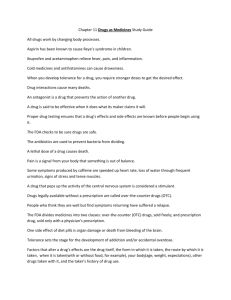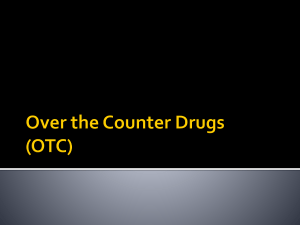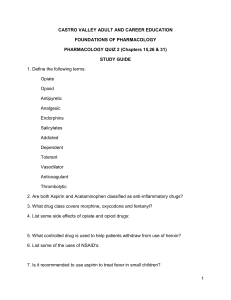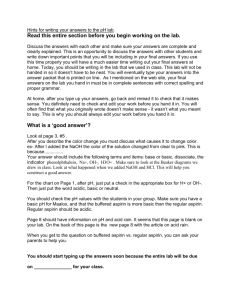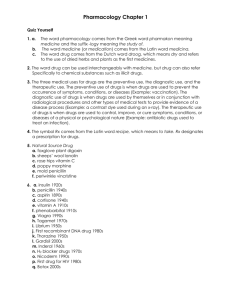Aspirin (acetylsalicylic acid) Non-Narcotic Pain Relievers 11/11/2013
advertisement
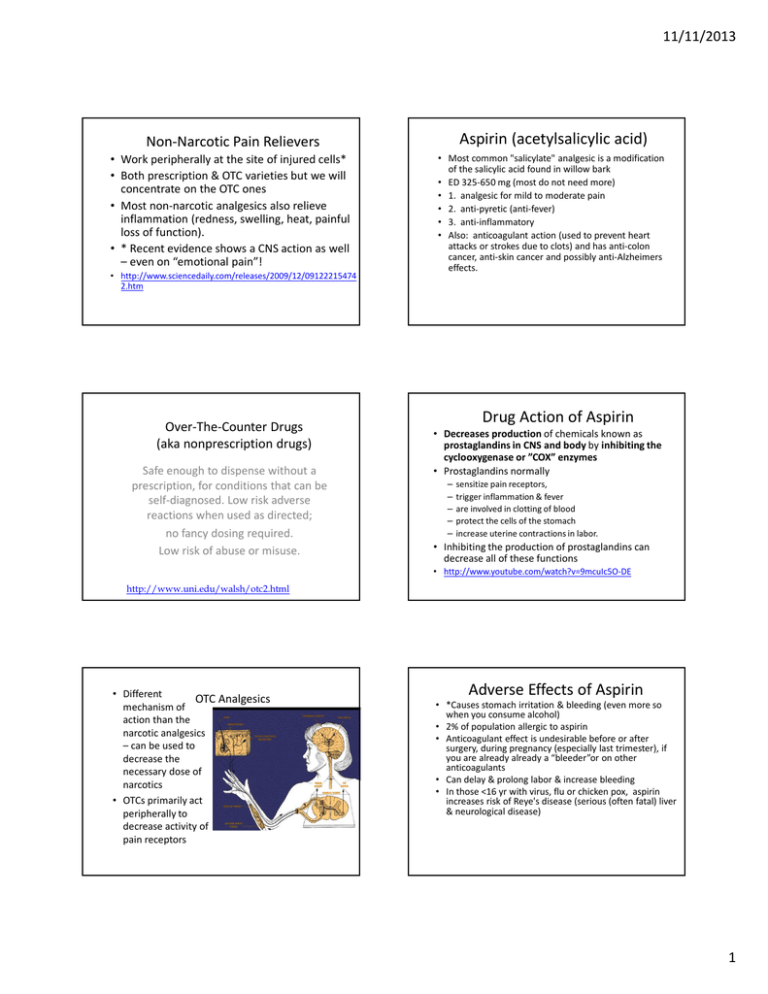
11/11/2013 Non-Narcotic Pain Relievers Aspirin (acetylsalicylic acid) • Work peripherally at the site of injured cells* • Both prescription & OTC varieties but we will concentrate on the OTC ones • Most non-narcotic analgesics also relieve inflammation (redness, swelling, heat, painful loss of function). • * Recent evidence shows a CNS action as well – even on “emotional pain”! • Most common "salicylate" analgesic is a modification of the salicylic acid found in willow bark • ED 325-650 mg (most do not need more) • 1. analgesic for mild to moderate pain • 2. anti-pyretic (anti-fever) • 3. anti-inflammatory • Also: anticoagulant action (used to prevent heart attacks or strokes due to clots) and has anti-colon cancer, anti-skin cancer and possibly anti-Alzheimers effects. • http://www.sciencedaily.com/releases/2009/12/09122215474 2.htm Over-The-Counter Drugs (aka nonprescription drugs) Safe enough to dispense without a prescription, for conditions that can be self-diagnosed. Low risk adverse reactions when used as directed; no fancy dosing required. Low risk of abuse or misuse. Drug Action of Aspirin • Decreases production of chemicals known as prostaglandins in CNS and body by inhibiting the cyclooxygenase or ”COX” enzymes • Prostaglandins normally – – – – – sensitize pain receptors, trigger inflammation & fever are involved in clotting of blood protect the cells of the stomach increase uterine contractions in labor. • Inhibiting the production of prostaglandins can decrease all of these functions • http://www.youtube.com/watch?v=9mcuIc5O-DE http://www.uni.edu/walsh/otc2.html • Different OTC Analgesics mechanism of action than the narcotic analgesics – can be used to decrease the necessary dose of narcotics • OTCs primarily act peripherally to decrease activity of pain receptors Adverse Effects of Aspirin • *Causes stomach irritation & bleeding (even more so when you consume alcohol) • 2% of population allergic to aspirin • Anticoagulant effect is undesirable before or after surgery, during pregnancy (especially last trimester), if you are already already a “bleeder”or on other anticoagulants • Can delay & prolong labor & increase bleeding • In those <16 yr with virus, flu or chicken pox, aspirin increases risk of Reye's disease (serious (often fatal) liver & neurological disease) 1 11/11/2013 Signs of Taking Too Much Aspirin (“salicylism) • Tinnitus (ringing in ears) or impaired hearing, dizziness, nausea & vomiting, thirst, rapid HR and breathing (panting), confusion • Increased risk if dehydrated • Lethal dose for average adult ~ 20g (60 tablets) Acetaminophen ("aspirin substitute” or “non-aspirin pain reliever") • 325-650mg (same potency as aspirin) Equal analgesic & antipyretic action • Not anti-inflammatory or anticoagulant • Less gastric distress & tinnitus, but more damaging to liver & kidneys with heavy use/overdose. Daily use is associated with risk of hypertension in some women • Can be used by those with aspirin allergy. • No risk of Reye’s syndrome in kids Acetominophen Overdose • 15 500 mg. tabs can cause liver damage (10 in child) • Symptoms don’t show up for 2-4 days, but by then the damage has been done • If overdose is recognized early, an antidote (acetylcysteine) can be administered. • Risk of liver damage increased in drinkers – should not use more than 4 500 mg or 6 325 mg tablets a day. Warning on package since 2009 (link below) • FDA says no one should exceed recommended dosage or take more than 10 days – considering limiting its OTC status & removing combo drugs like Vicodin & Percoet from market Ibuprofen( e.g. Motrin, Advil) • Both OTC (200 mg) & prescription (higher doses); used every 4-6 hr • More potent than aspirin or acetominophen (take less) • More effective for certain conditions (inflammation, joint problems, sports injuries, dysmenorrhea, dental pain, musculoskeletal pain) • Weaker anticoagulant effect than aspirin and, if used regularly, actually blocks or reduces the anticoagulant action of aspirin! Naproxen (OTC Aleve; Naprosyn or Anaprox) • Very similar to ibuprofen but somewhat different time course (slower onset but lasts longer; taken just twice a day). – Ibuprofen peaks in 1-2 hrs, half-life 2 hrs – Naproxen peaks in 5 hrs, half life 12 hrs • Both naproxen & ibuprofen are similar enough to aspirin that they should not be used by those with aspirin allergy. • Similar stomach irritation & should be avoided by those with kidney disease. • 200 - 220mg OTC, higher doses by prescription • Naproxen may be cardioprotective like aspirin Ketoprofen (e.g. Orudis, Actron) • Same analgesic/anti-inflammatory family • More potent, but otherwise not different in its effects/risks • OTC dosage is 12.5 mg/4-6 hrs whereas prescription dose is 25-75 mg/6-8 hrs http://www.youtube.com/watch?v=OjOKxVseZ8I 2 11/11/2013 “Non-Steroidal Anti-Inflammatory Drugs” (NSAIDS) • All of these except acetominophen relieve inflammation. (additional prescription NSAIDS have greater risk of side effects) • The other group of potent (& hence prescription) anti-inflammatory drugs are corticosteroids like prednisone. Watch Out for New Drugs • Vioxx had to be pulled from the market because studies of long-term users revealed a doubling of heart attack and stroke risks. • Voluntary removal of Celebrex & Bextra followed. • What risk is acceptable? No drug is completely safe. • After further review FDA voted to return Celebrex to market, with stronger “black box” warnings The Down Side • NSAIDS taken chronically by 15-20 million for inflammatory conditions like arthritis • Stomach bleeding in 40% of chronic users, 12% of occasional users • 100,000/yr in US hospitalized for NSAID gastric problems; 16,000/yr die from this! • Since 2009 package must include warning about this danger Newest Advance- Sort Of……. • Enzyme (cyclooxygenase or COX) producing prostaglandins is found in different forms in different parts of body • OTC NSAIDS inhibit both COX1 and COX 2 and thus affect all of prostaglandins functions • New selective “COX2 inhibitors” inhibit “pain & inflammation” prostaglandins but not those that protect stomach or affect platelets fewer stomach & anticoagulant side effects. – Celebrex (celecoxib) 200 mg – Vioxx (rofecoxib) 25 mg – Were very widely prescribed Prescription only BUT……… • OTC analgesics, being readily available, are involved in 25% of suicide attempts seen in the DAWN ERs Cold and Flu Medications • Often contain a “shotgun”mix of ingredients to relieve symptoms: – decongestant for stuffiness – analgesic/antipyretic – antihistamine – anti-tussive (anti-cough) – some include alcohol – some include stimulants • Not everyone needs this fixed combination of ingredients! More drugs= more risk of side effects, interactions, confusion about what one’s taking • More “individualized” preparations now available • http://www.youtube.com/watch?v=dZAIStsULfA 3 11/11/2013 Decongestants • Mild stimulants (sympathomimetics) which constrict blood vessels in nose, sinuses, reducing stuffiness & runny nose • Examples: – phenylephrine – pseudoephedrine (now behind the counter) Anti-tussives (cough-suppressants) • Decrease the cough reflex - good for when you have a tickly, nonproductive cough. – codeine – diphenhydramine (antihistamine) – dextromethorphan (related to codeine but nonnarcotic) • Risks: jitters, may impair sleep, may increase BP http://www.youtube.com/watch?v=54U7URMCnck&feature=related Antihistamines • Block the action of histamine, which triggers allergytype responses (itchy eyes, sneezing & runny nose, hives) – Several “pheniramines” • • • • chlorpheniramine (in Allerest, Triaminacin, Chlortrimeton) brompheniramine (in Dimetapp) dexbrompheniramine (in Drixoral) “First-Generation” dipheniramine (in Actifed) – diphenhydramine (in Benedryl & others) – doxylamine (in Nyquil) – – – – loratadine (Alavert or Claritin) “2nd generation” cetirizine (Zyrtec) fexofenadine (Allegra) Don’t cross BBB as well- this decreases sleepiness High Dose Dextromethorphan Abuse • Street names: DM, DXM, Dex, Drex, Skittles, Tussin, Vitamin D, Robo, Rojo, Red Devils • As dose increases you first get intoxication, then a PCP type hallucinogenic action • Possible arrhythmias, seizures, loss of consciousness, possible death • Recently 8,000-10,000 DAWN ER visits/yr • ~50,000 calls to CDC Poison Control Center • http://www.youtube.com/watch?v=bIuX5T_Ux9M • http://www.youtube.com/watch?v=HcOWbxXwTD8 Other Uses • Antihistamines are also effective as – anti-motion sickness drugs (like Dramamine (dimenhydrinate) or Bonine (meclizine)) – cough suppressants (like Benedryl Cough Syrup) – OTC sleep aids (e.g.Bayer PM, Tylenol PM, all the “PMs” contain the same diphenhydramine as in Benedryl) Expectorants • Loosen or thin phlegm to make it easier to clear congested lungs with a productive cough • Example: – Guaifenesin – Current controversy: parents/babysitters inappropriately sedating of kids with antihistamines 4 11/11/2013 Regulations Affecting Medications • 1906 Pure Food & Drug Act (drug must be pure & accurately labeled) • 1937 Federal Food, Drug & Cosmetic Act (drug must be demonstrated to be safe when used as directed) (now also require safety updates) • 1962 Kefauver-Harris Amendment (drug must be demonstrated to be effective before it can be marketed for that use) • Evaluation of whether drugs meet these reqs continues today. FDA seeks to prevent future drug problems. Herbal or Natural Remedies or “Dietary Supplements” Are “natural” remedies better? Are “natural” remedies safe? Are “natural” remedies worth the money? Are “natural remedies” “drugs”??? • “Natural” plant products are not distinctly different from “drugs”. The majority of drugs are derived from or based on active ingredients found in plants. • “Natural” does not necessarily mean “safe”. Nature is full of poisons! http://www.pacificbiolabs.com/drug_stages.asp#ind Right Next to the OTCs…. • For a long time natural remedies had a relatively small market in the US and were mostly sold in funky little health food stores. • More recently supplements became a booming business with products sold everywhere, including on the internet. • More users more adverse reactions, so in nineties FDA tried to bring supplements under their control. 5 11/11/2013 The FDA’s Logic • If a supplement contains biologically active compounds, those compounds qualify as “drugs” with all the usual concerns we have about drugs (dose, side effects, interactions, adverse reactions, etc.) • If they don’t contain active ingredients (and some don’t), they are frauds, a waste of money, or at best, placebos. • But supplements had huge lobby support, so the FDA essentially lost: • 1994 Dietary Supplement Health Education Act allowed products labeled as such to be essentially free from FDA regulation as long as they didn’t claim to treat a disease. • http://www.pbs.org/wgbh/pages/frontline/sh ows/altmed/view/4_hi.html The Supplement Lobbyists Won • Purity, safety, dose, effectiveness and batch-to-batch quality control was NOT regulated by FDA as they were for drugs • No guarantee that the herbs/supps were what they said they were or what else might be present • No FDA regulation of benefits claimed on labels or in ads; no research required. • Unlike “drugs” no pre-testing or research required to demonstrate safety or effectiveness!! • For the last 16 yrs it has been “Buyer beware” (but no one tells the buyer this). • http://www.youtube.com/watch?v=YKyM8Dz8m ec • Finally, in 2010, FDA tried again and made the first positive step in the supplement industry – manufacturers must follow good manufacturing practices to assure products are pure and they must label the ingredients. • http://www.quicklabel.com/blog/2010/12/newgmp-labeling-laws-for-dietary-supplements-inthe-usa/ • Now FDA is considering requiring scientific support for the claims made by dietary supplements • http://www.youtube.com/watch?v=TfJdz2g1i4 Even well-known herbs aren’t safe for all • Chamomile –used as a digestive and antiinflammatory, but may irritate those with ragweed/flower allergies • Echinacea – may boost immunity but shouldn’t be used in pregnancy or by those with autoimmune disorders 6 11/11/2013 Examples of herbal side effects An Increasing Risk • Ginkgo – bleeding • St. John’s Wort – GI upset, fatigue, dizziness, confusion, dry mouth, allergic reactions • Ephedra – hi BP, arrhythmias, anxiety, insomnia, tremors, kidney stones • Kava – sedation, slurring, ocular & neck spasms, rash, Parkinson’s Disease symptoms, possible liver damage • “Supplements”(mostly imported or bought on internet) laced with hidden, often dangerous drugs • http://www.fda.gov/ForConsumers/Consumer Updates/ucm153239.htm • Supplements can interact with other medications so should always be mentioned when doctors ask what you are taking. • Sample Drug Interactions • • • • • Gingko & blood thinners St. John’s Wort & antidepressants Ephedra & caffeine, decongestants, stimulants Ginseng and warfarin (Coumadin) Kava & sedatives, alcohol, sleeping aids, antipsychotics 7
